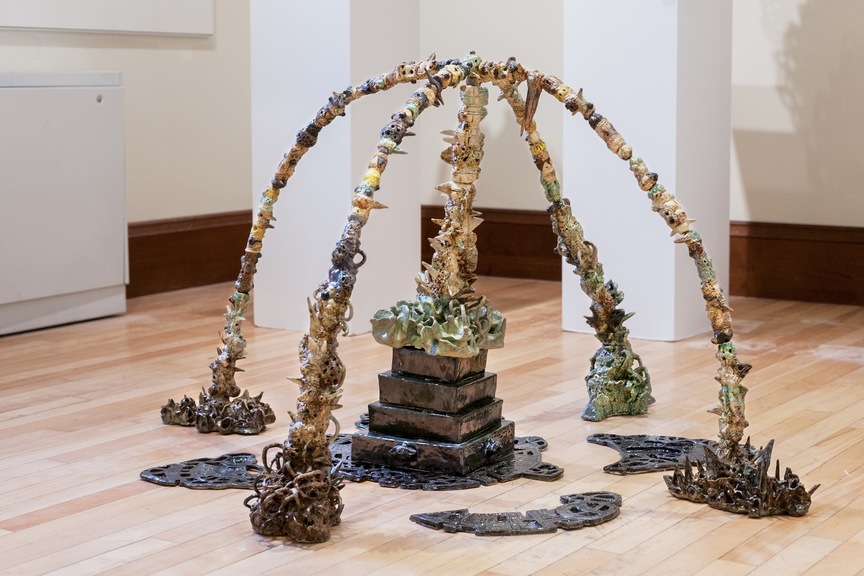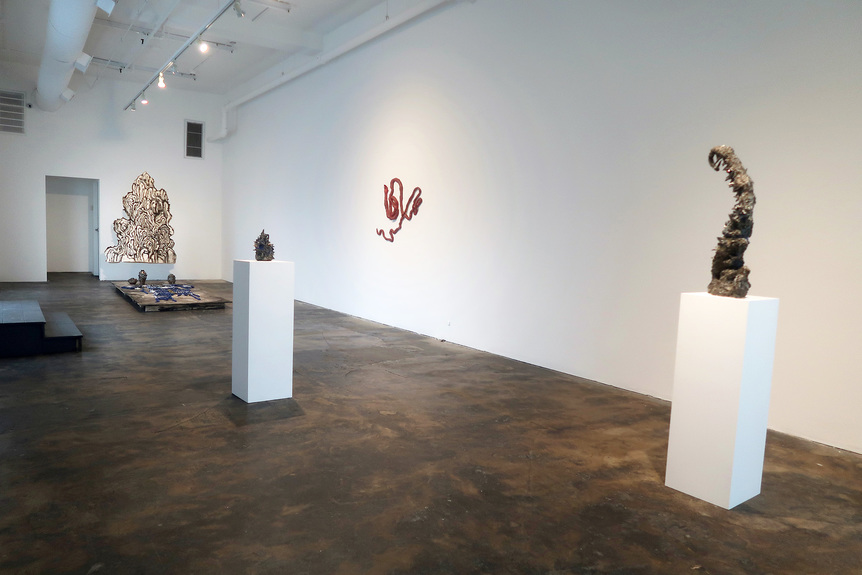
R
E
V N
E
X
T
Heidi Lau was born in Oakland, California, and raised in Macau, but it wasn’t until she moved to New York City, where she currently lives and works, that she began to gain a fuller understanding of where she came from. Her craggy, ruinous tabletop and large-scale ceramic sculptures are drawn from her own family history and to a rapidly changing Macau. Growing up, she regularly attended Taoist temples with her grandmother, who was dedicated by Lau’s great-grandmother to be the goddaughter of Yan Luo Wang, the guardian of the gates of hell. These abstract ideas of an afterlife, which seemed quaint in childhood, have gained a renewed resonance for Lau since she lost her mother to leukemia two years ago. Just as her grandmother was thought to be a connection to the underworld for the living, Lau views her work as a threshold to another realm while being fully engaged in the current moment. On the heels of closing her first solo exhibition in Los Angeles and looking forward to her presentation at the Macau Pavilion in the upcoming Venice Biennale, Lau talked to ArtAsiaPacific about the convergence of generations in her work.
You’ve moved cities several times. How do these locales figure in your work?
As soon as I was born, my parents realized they couldn’t afford to live in the United States and moved back to Macau. A few years after [Macau’s transfer of sovereignty from Portugal to China] in 1999, there were a lot of changes, and I didn’t have the vocabulary for what was happening and how I felt about it. I think a lot of people had similar sentiments. We were expected to go along with it, but people in Macau continue to worry about prospects for the future. It wasn’t until I moved to New York in 2005 and read postcolonial literature that I understood where those feelings of anxiety and confusion stemmed from. It took me going away and being in the US to understand the implications of colonialism in the place where I grew up and spent most of my life. In Macau, we grew up learning Chinese history or world history but never knew what happened just down the street from us. Now that the former Portuguese colony has been returned to China, what does that mean? Who has the right to speak for the city and its citizens?
When did you begin working with ceramics and why is that your medium of choice?
I’m self-taught in ceramics. I picked it up during a residency in Ireland in 2010. The material is literally and figuratively embedded with so much history—depending on where it is sourced, the clay possibly could have traveled the globe before my ancestors were even born, and when we die, we liquefy and return to the soil. Working with this material symbolizes my own decolonization. Ming Dynasty blue and white porcelain is the typical image that comes up when one speaks of Asian pottery, especially in the West. It is thought of as something ornate, fragile and hollow. In opposition to that stereotype, I’m drawn to hand-building with clay because it’s very tactile. I’m able to scratch at it and imbue it with different emotions and physical gestures. It’s a material that is able to defy the notion that ceramics is simply decorative.
Soon after Macau became part of China, my family had to close our perfume store because we lost most of our Portuguese clientele. I grew up around porcelain and glass bottles, and when I became an artist, I started to have this fantasy that since all of these materials could be reclaimed and washed up from the ocean, perhaps somehow this clay I am using now is washed-off, particulate matter from the vessels in my family’s store. It’s a romantic notion, but especially since in Macau we have floods all the time, not a complete fantasy or impossibility.
Could you share some insights into the Macau Pavilion at the Venice Biennale?
The actual pavilion itself is like a house with a courtyard, reminiscent of older houses you would find in Macau. When you walk in, there are sculptures that reference the Taoist creation myth, and inside the house each room is divided into different aspects of Macau identity that speak to both me and [the curator] Lam Sio Man. In the largest room, we are building a “Recreation Garden,” inspired by the Lou Lim Ieoc Garden, created by Lou Kau, one of the first casino tycoons in Macau in the 19th century. I’ll be building a large scholar’s rock from memory and, drawing upon the fact that the garden used to also be a theater, I’m working with a Cantonese opera group based in New York’s Chinatown to record a song that my grandmother used to sing, called “Song of Exile.”
You would never connect the garden to the glitzy contemporary casinos in Macau but we want to point out how inseparable our identity has been to alternative business models like casinos and [other mafia enterprises]. It’s always been a part of our society but it has never caused such a class divide until now. When people talk about casinos it’s always linked to the economy and progress but the history of [Lou Kau’s] first casino was actually a complete failure. He ended up hanging himself in his mansion.
So is this garden a critique of Macau’s USD 37.5-billion dollar casino industry?
I’m critiquing but also connecting what is happening currently to our origins. I’m attempting to resolve some of the confusion I felt during and after the handover by connecting Macau’s rapid change, so-called progress, and vision for the future to the very roots of the culture.
What are your impressions now when you go back to Macau?
I spend as much time in Macau as possible because my father and older brother still live there. Every time I visit, I sense from local news to general sentiment to social media that there is a hunger to hear more individual stories and commemorate collective memories. The pre-handover generations have always grown up in “ruins,” both in a material and historical sense, and these are historical places that we were allowed to interact with and a backdrop to form real memories. Nowadays, these places, while preserved on the exterior because they are listed as landmarks, tend to be completely gutted in the inside and “museum-ified,” or are spaces that cater to tourists. This imbalance of space extends to so many aspects of Macau residents’ lives—our city has one of the highest GDPs in the world, but our hospitals are understaffed and ill-equipped; the most vulnerable citizens who live in low-lying areas risk losing their life savings and homes every year to typhoons. The priority is not to local, native residents, but what will bring in more visitors and revenue to casinos.
Your solo show in Los Angeles at AA|LA gallery, titled “Blood Echoes,” explored your connection to your ancestors. How does family lineage figure in your work?
The sculptures in “Blood Echoes” were all funereal in topic and theme. Some were made for my mom, who passed away from leukemia two years ago, and the sculptures resembled bone marrow or the spinal cord. In the past four years, my visits to Macau have been preoccupied with hospital visits and funerals for my grandparents and mother. They were my ties to Macau, and because they are no longer around, I have been trying to seek a connection to Macau in other ways. At the same time, I want to stretch the timeline of these people and their short lives in Macau as long as possible.
One of the rooms at the Macau Pavilion in the Venice Biennale is called “Ancestral Home” and it’s dedicated to them. It consists of an altarpiece packed with perfume bottles I made based on my memories of my family’s perfume store. Another piece is an anthropomorphic grotto with mechanically waving palm leaf fans dedicated to my grandma, who always carried a hand fan with her. I always felt that her sense of time was measured by the waving of the fan and not by a mechanical clock. The motion of a fan is like a pendulum: perpetual and [steady]. Finally, we are also installing a sound and light piece in the bathroom—when my grandma used the bathroom she could often be heard saying, “Excuse me, please make way” to the spirits because the bathroom is the most yin part of the house. We will be installing a speaker that plays the short Cantonese phrase in the bathroom and the lighting will be green, an aesthetic popular in campy 1980s and ’90s Hong Kong ghost movies. I think it’s remarkable that she was requesting passage for herself in her own house, as if she was a visitor or guest living on the borrowed time and space of our ancestors. Her call was never returned—but now, in the future, it will be.
Jennifer S. Li is the Los Angeles desk editor for ArtAsiaPacific.
This interview has been edited for length and clarity.
The 58th Venice Biennale is on view from May 11 until November 24, 2019.
To read more of ArtAsiaPacific’s articles, visit our Digital Library.




















